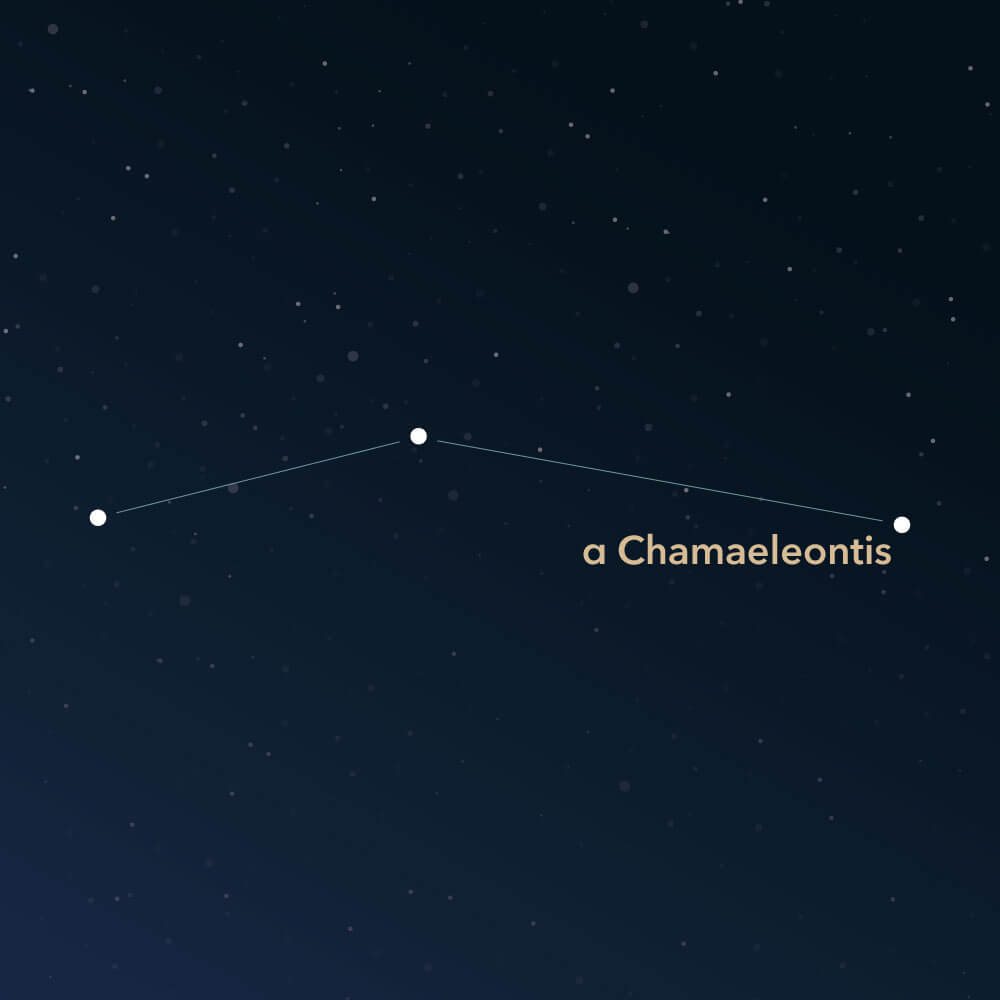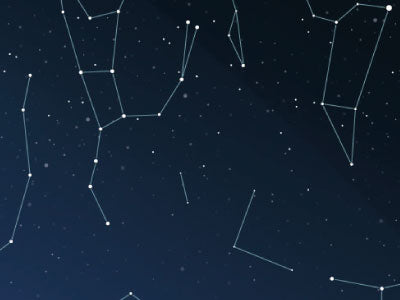The constellation Chamaeleontis
Caractéristiques
- Nom latin
- Chamaeleontis
- Hémisphère
- Hémisphère sud
- Visibilité
- June - August
- Région
- 132 deg²
- Étoile la plus brillante
- α Chamaeleontis (HIP number 40702)
- Spécialités
- Planetary nebulae, open star clusters, molecular clouds

The Chamaeleon (Latin: Chamaeleontis) is a small and inconspicuous constellation in the southern sky. It was introduced by Dutch sailors Frederick de Houtman and Pieter Dirkszoon Keyser between 1595 and 1597. It is in a region of the sky with some interesting objects, such as a series of molecular clouds.
Hemisphere, visibility, and area
The constellation of Chamaeleon is located in the southern hemisphere near the South Celestial Pole, the fixed extension of the earth's axis. Due to its location, it cannot be observed north of the equator. It is only visible up to 5° north latitude, which is roughly equivalent to Bogota in Colombia. In the southern hemisphere, it can be seen all the way to the South Pole.
The months of June to August offer the best time for observing the Chamaeleon.
It stretches across an area of approximately 132 square degrees in the night sky. With this size, it ranks 79th among all 88 constellations.
Its size and faint stars make it difficult to locate the Chamaeleon in the night sky. There are no bright stars in the region of the constellation, as it contains only stars that are not brighter than fourth magnitude.
To find it anyway, it is helpful to look for the bright star Miaplacidus (Latin: β Carinae) in the neighboring constellation Carina. Due to its brightness, this star can easily be found. Miaplacidus is located north of the Chamaeleon constellation.
Other neighbors include Volans and Mensa to the east, as well as Octans and Apus to the south. The Musca constellation borders it to the west. They can also serve as good reference points.
Most visualizations show only three stars in Chamaeleon, which are connected by a line with a slight bend. The brightest of these three stars is α Chamaeleontis (Alpha Chamaeleontis). It is a whitish-bluish star with an apparent magnitude of about 4. The star is roughly 80 light-years from earth.
Specialties in the constellation
Various deep-sky objects are located in the area of the Chamaeleon, including a planetary nebula, an open star cluster, and several molecular clouds.
The planetary nebula bears the catalog number NGC 3195 and is not exceptionally bright. It has an apparent magnitude of only around 11.6 and is, therefore, not visible to the naked eye. It was discovered by the British astronomer John Herschel in February 1835.

The numerous molecular clouds in the constellation are known as Chamaeleon Dark Clouds. They are a striking group of stars and consist of a mass of gas and dust that corresponds to tens of thousands of solar masses. Their distance from earth is estimated to be 400 to 600 light-years.
History
The Dutch expedition in 1595, which set out to reach the legendary Spice Islands in the south, conducted a research project to measure and document the positions of all bright stars in the southern hemisphere.
Pieter Dirkszoon Keyer, the navigator of the fleet, measured the positions of 135 stars, and together with Frederick de Houtman, the brother of the fleet commander, they defined 12 new constellations.
The Latin name Chamaeleontis was eventually chosen due to their extended stay on the island of Madagascar, where they observed many chameleons.
Constellation Visibility Tool
Los Angeles, USA
34.05°, -118.24°
Constellation Observing Guide
This guide shows when the constellation is visible above the horizon and provides the optimal viewing window when the sky is darkest. Times are displayed in the location's timezone (PDT).
No Optimal Window Found
The constellation's visibility doesn't overlap with the darkest part of the night during the next 48 hours.
Alternative Viewing Options
You can still observe the constellation when it's above the horizon, but there may be some twilight interference. Consider checking again in a few days as visibility patterns change throughout the year.
Constellation Visibility from Your Location
0
Visible Stars
3
Never Rise
0
Always Up
0%
Visible
3 stars are too far south to be visible from your latitude (34.1°N)
Constellation Visibility
When the constellation is above the horizon (includes daylight hours)
Rises
Never Rises
Never Rises
Fully Up
Never Rises
Starts Setting
Never Rises
Never Rises
Fully Set
Never Rises
Never Rises
Above Horizon Times
Includes daylight hours when stars aren't visible to naked eye.
Astronomical Night
When the sky is darkest (sun >18° below horizon)
Dark sky begins
21:03
Jul 26
Dark sky ends
05:03
Jul 27
Darkest Sky Period
Sun more than 18° below horizon. Best for faint objects.
Observing Tips
Lire d'autres articles intéressants

An overview of all 88 constellations
Learn more about all 88 constellations and read interesting information about the mythology, visibility, and features.

Application Planétarium
Découvrez le ciel nocturne avec notre application de planétarium !
Disponible pour iOS et Android.

Nommez une étoile dans la constellation The Chamaeleon
Name a star in a constellation and create something that lasts for eternity.